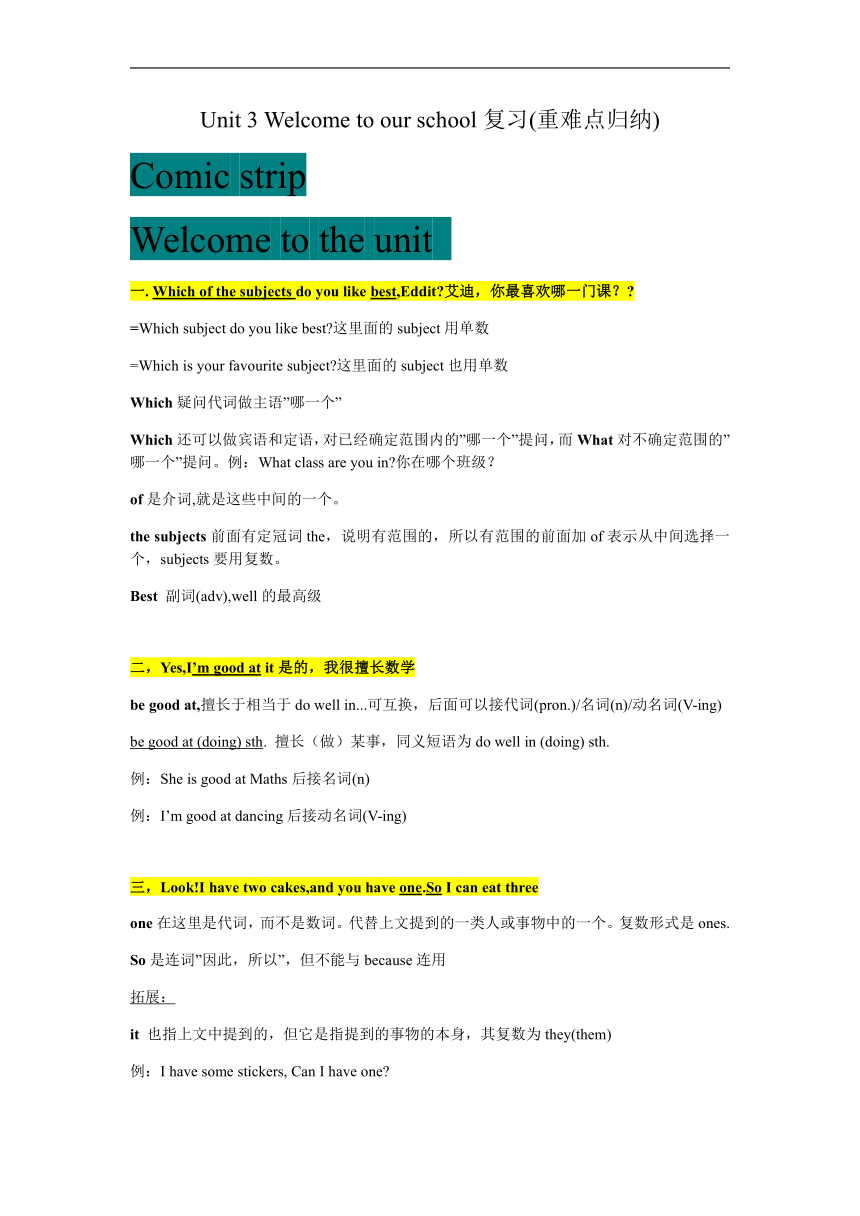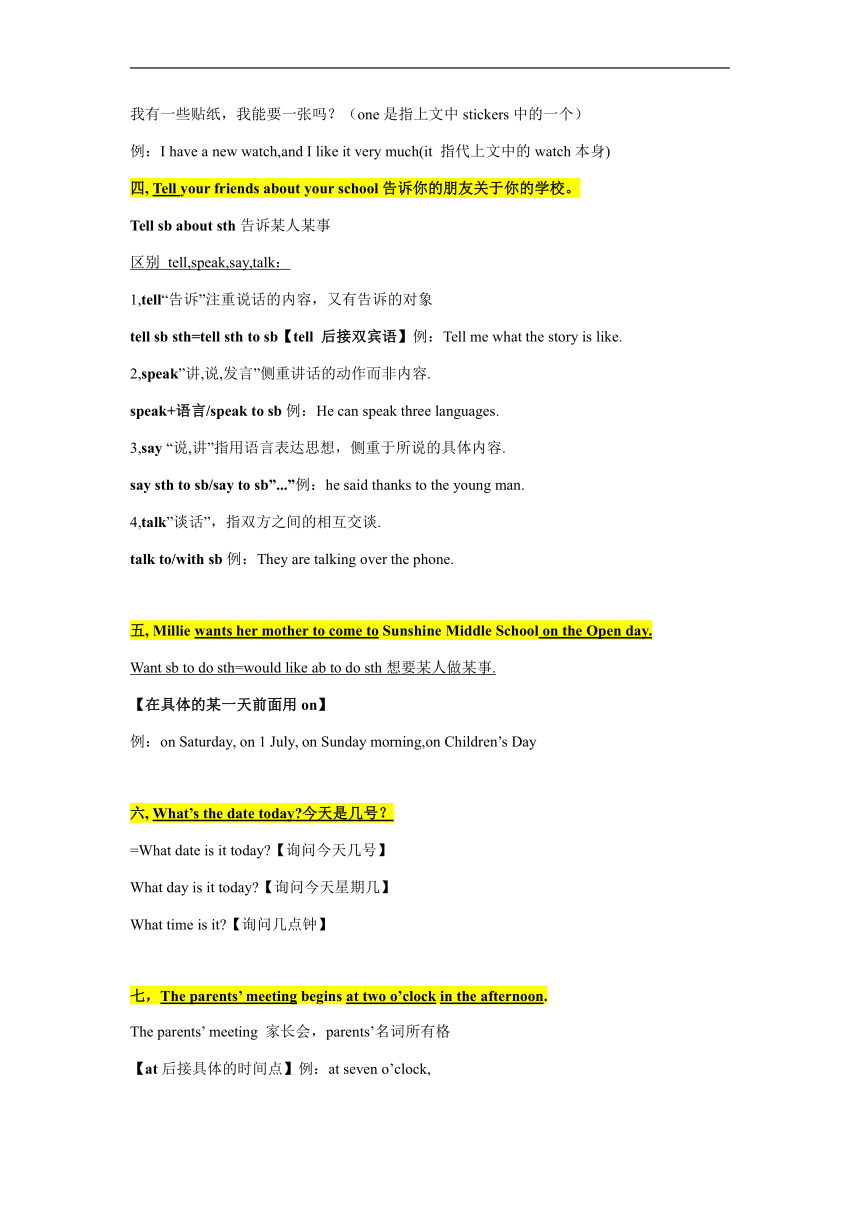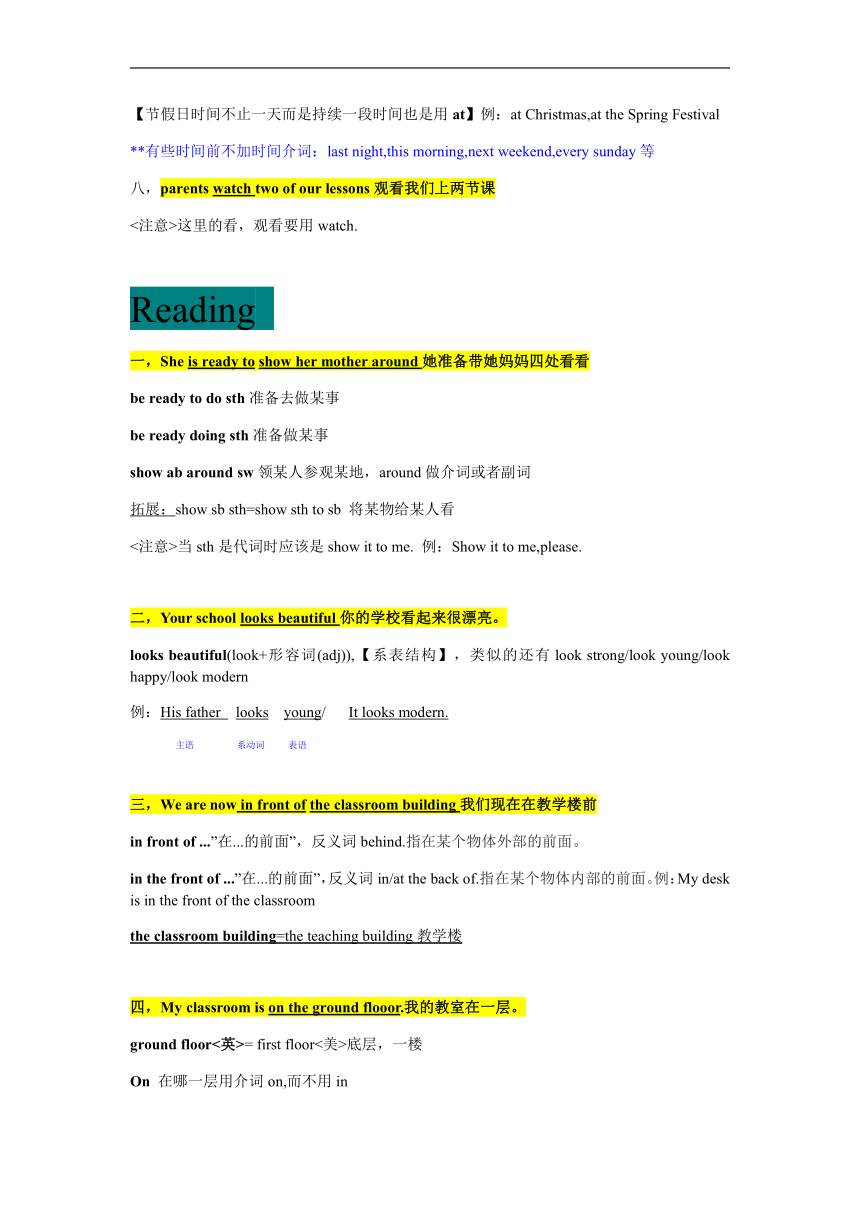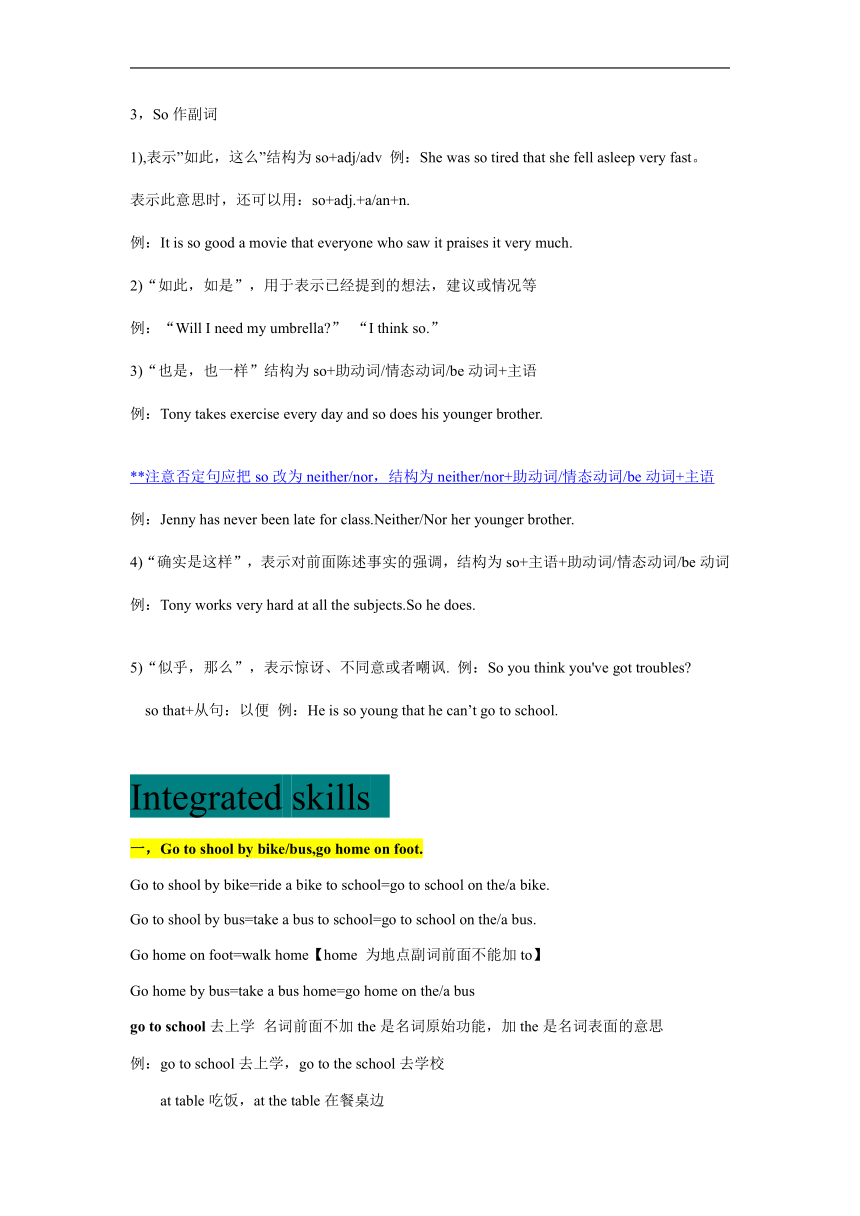牛津译林版七年级上册 Unit 3 Welcome to our school. Comic strip & Welcome to the unit 复习(重难点归纳)
文档属性
| 名称 | 牛津译林版七年级上册 Unit 3 Welcome to our school. Comic strip & Welcome to the unit 复习(重难点归纳) |  | |
| 格式 | zip | ||
| 文件大小 | 188.5KB | ||
| 资源类型 | 教案 | ||
| 版本资源 | 牛津译林版 | ||
| 科目 | 英语 | ||
| 更新时间 | 2022-09-07 16:15:19 | ||
图片预览





文档简介
Unit 3 Welcome to our school复习(重难点归纳)
Comic strip
Welcome to the unit
一. Which of the subjects do you like best,Eddit 艾迪,你最喜欢哪一门课?
=Which subject do you like best 这里面的subject用单数
=Which is your favourite subject 这里面的subject也用单数
Which疑问代词做主语”哪一个”
Which还可以做宾语和定语,对已经确定范围内的”哪一个”提问,而What对不确定范围的”哪一个”提问。例:What class are you in 你在哪个班级?
of是介词,就是这些中间的一个。
the subjects前面有定冠词the,说明有范围的,所以有范围的前面加of表示从中间选择一个,subjects要用复数。
Best 副词(adv),well的最高级
二,Yes,I’m good at it是的,我很擅长数学
be good at,擅长于相当于do well in...可互换,后面可以接代词(pron.)/名词(n)/动名词(V-ing)
be good at (doing) sth. 擅长(做)某事,同义短语为do well in (doing) sth.
例:She is good at Maths后接名词(n)
例:I’m good at dancing后接动名词(V-ing)
Look!I have two cakes,and you have one.So I can eat three
one在这里是代词,而不是数词。代替上文提到的一类人或事物中的一个。复数形式是ones.
So是连词”因此,所以”,但不能与because连用
拓展:
it 也指上文中提到的,但它是指提到的事物的本身,其复数为they(them)
例:I have some stickers, Can I have one
我有一些贴纸,我能要一张吗?(one是指上文中stickers中的一个)
例:I have a new watch,and I like it very much(it 指代上文中的watch本身)
四, Tell your friends about your school告诉你的朋友关于你的学校。
Tell sb about sth告诉某人某事
区别 tell,speak,say,talk:
1,tell“告诉”注重说话的内容,又有告诉的对象
tell sb sth=tell sth to sb【tell 后接双宾语】例:Tell me what the story is like.
2,speak”讲,说,发言”侧重讲话的动作而非内容.
speak+语言/speak to sb例:He can speak three languages.
3,say “说,讲”指用语言表达思想,侧重于所说的具体内容.
say sth to sb/say to sb”...”例:he said thanks to the young man.
4,talk”谈话”,指双方之间的相互交谈.
talk to/with sb例:They are talking over the phone.
五, Millie wants her mother to come to Sunshine Middle School on the Open day.
Want sb to do sth=would like ab to do sth想要某人做某事.
【在具体的某一天前面用on】
例:on Saturday, on 1 July, on Sunday morning,on Children’s Day
六, What’s the date today 今天是几号?
=What date is it today 【询问今天几号】
What day is it today 【询问今天星期几】
What time is it 【询问几点钟】
The parents’ meeting begins at two o’clock in the afternoon.
The parents’ meeting 家长会,parents’名词所有格
【at后接具体的时间点】例:at seven o’clock,
【节假日时间不止一天而是持续一段时间也是用at】例:at Christmas,at the Spring Festival
**有些时间前不加时间介词:last night,this morning,next weekend,every sunday等
parents watch two of our lessons观看我们上两节课
<注意>这里的看,观看要用watch.
Reading
一,She is ready to show her mother around她准备带她妈妈四处看看
be ready to do sth准备去做某事
be ready doing sth准备做某事
show ab around sw领某人参观某地,around做介词或者副词
拓展:show sb sth=show sth to sb 将某物给某人看
<注意>当sth是代词时应该是show it to me. 例:Show it to me,please.
二,Your school looks beautiful你的学校看起来很漂亮。
looks beautiful(look+形容词(adj)),【系表结构】,类似的还有look strong/look young/look happy/look modern
例:His father looks young/ It looks modern.
主语 系动词 表语
三,We are now in front of the classroom building我们现在在教学楼前
in front of ...”在...的前面”,反义词behind.指在某个物体外部的前面。
in the front of ...”在...的前面”,反义词in/at the back of.指在某个物体内部的前面。例:My desk is in the front of the classroom
the classroom building=the teaching building教学楼
四,My classroom is on the ground flooor.我的教室在一层。
ground floor<英>= first floor<美>底层,一楼
On 在哪一层用介词on,而不用in
五,We also have an art room,a music room and two computer rooms我们还有一间美术室,一间音乐室和两间电脑室。我们还有一间美术室,一间音乐室和两间电脑室。.
also 表示”也”,和too的意思一样
区别:also用于句首或者句中,而too用于句末。
an art room,a music room
an和a的用法: 取决于a/an后面的第一个单词的读音。
单词的第一个音素是元音音素,用an--an art/ɑ t/; 是辅音音素,用a--a music/ mju z k/。
六,We have meetings there.我们在那里开会。
=hold meetings
单次或一次用have a meeting/hold a meeting
拓展:
开班会 have/hold a class meeting,
开运动会have/hold a sports meeting.
七,Who’s that man in a white shirt?=Who’s that man wearing a white shirt
【in a white shirt:介词短语做后置定语,修饰前面的名词man】
in表示”穿着,戴着”相当于wearing.
例:The girl looks nice in the red coat【in+服装】=The red coat looks nice on the girl.【on+sb.】
八,Our parents come and visit our school on this day.
on时间介词,具体的某一天前面用on
例:on Sunday,on 1 July,on Sunday morning,on Children’s day.
So 的用法
so作连词表示”因此,所以” 例:I have two cakes,and you have one.So I can eat three。
So作形容词,表示”是这样的,是真的”例:The newspapers claim she killed him in self defence but that just isn’t so.
3,So作副词
1),表示”如此,这么”结构为so+adj/adv 例:She was so tired that she fell asleep very fast。
表示此意思时,还可以用:so+adj.+a/an+n.
例:It is so good a movie that everyone who saw it praises it very much.
2)“如此,如是”,用于表示已经提到的想法,建议或情况等
例:“Will I need my umbrella ” “I think so.”
3)“也是,也一样”结构为so+助动词/情态动词/be动词+主语
例:Tony takes exercise every day and so does his younger brother.
**注意否定句应把so改为neither/nor,结构为neither/nor+助动词/情态动词/be动词+主语
例:Jenny has never been late for class.Neither/Nor her younger brother.
4)“确实是这样”,表示对前面陈述事实的强调,结构为so+主语+助动词/情态动词/be动词
例:Tony works very hard at all the subjects.So he does.
5)“似乎,那么”,表示惊讶、不同意或者嘲讽. 例:So you think you've got troubles
so that+从句:以便 例:He is so young that he can’t go to school.
Integrated skills
一,Go to shool by bike/bus,go home on foot.
Go to shool by bike=ride a bike to school=go to school on the/a bike.
Go to shool by bus=take a bus to school=go to school on the/a bus.
Go home on foot=walk home【home 为地点副词前面不能加to】
Go home by bus=take a bus home=go home on the/a bus
go to school去上学 名词前面不加the是名词原始功能,加the是名词表面的意思
例:go to school去上学,go to the school去学校
at table吃饭,at the table在餐桌边
in hospital住院in the hospital在医院
go to bed去睡觉,go to the bed向床边走去
二,It is a long way from my home to the school【from...to...从...到...】
从我家到学校有很长的一段路。home在这里是名词
三,It takes me about half an hour to get to school到学校花费我半小时。
【It为形式主语,真正的主语是后面的动词不定式短语】
it takes sb.time to do sth花费某人时间做某事=sb spend time(money)doing on sth
【拓展】英语中几个花费的用法:
take:It 做主语时用take 表示花时间。
spend:人做主语,sb spend(s) some time/money on sth/doing sth. 例:I spend 2 dollars on it.
cost: 物做主语,sth cost sb...money 例:This book cost me 2 dollars.
pay: 遇到for 用pay,sb pay(s) money for sth 例:I paid 2 dollars for it
half and hour半小时 one hour and a half=one and a half hours一个半小时
四,It’s open from 8 a.m. to 5:30p.m.从上午8点开放到下午5点半
open 短动词,打开,开门(营业),与点/时间搭配用
be open 【系表结构】open是形容词,意为”开着的”表示的动作延续的状态。是个长动词。
例:The shop opens at 5:00a.m.and closes at 8:00p.m.
例:The shop is open from 5:00a.m. to 8:00p.m.
五,There are all kinds of books in our library我们的图书馆例有各种各样的书.
There be 句型:某地有某人或某物,强调"存在"。be动词必须和主语在人称和数量上保持一致。例:There is some milk in the bottle.
*There be 后面的名词是句子的主语,所以There be 句型属于倒装句。
all kinds of 各种各样的:kind,n 种类,谓语动词单复数与kind保持一致。
例:This kind of pen(s) is cheap.
Do you borrow books from the library 你从图书馆借书吗?
borrow...from...向某人借某物,借进来。句型borrow sth from sb
lend...to...将某物借给某人,借出去。句型lend sth to sb
Bring me a birthday cake on your way back.回来的时候给我带个生日蛋糕。
Bring 带某物回来,相当于take something/someone with you when you come back from somewhere. 例:Don’t forget bring sth back for the kids.
on your way back:on one’s way to...在去...地方的路上
例:on the way to school在去上学的路上、on my way to the supermarket在我去超市的路上
例:on one’s way home【home为地点副词】
Task
一,Thanks for your letter.感谢你的来信
【Thanks for sth=Thank you for sth】因某事而感谢你
Thank sb for doing sth因某事而感谢某人 例:Thank you for helping me(to) learn English.
二,study at hope Middle School在希望中学学习.
Study学习
区别:study和learn
learn:通常指通过学习,练习或由别人教授以获得某种知识或者技能,侧重学习的成果。learn的用法比study广。例:It is difficult to learn English.
Study:指的是阅读、背诵或是上学以便学会某个学科,侧重学习的过程。
例:I studied but I did not learn anything.我学了,但是什么都没学会
三,We only have a few classrooms
only仅仅,只有
a few很少,几个
重点区别:few/a few, little/a little
few “很少,几乎没有”+可数名词复数【否定句】例:He has few friends他几乎没有朋友.
a few”一些”+可数名词复数【肯定句】例:He has a few friends他有一些朋友。
little “很少,几乎没有”+不可数名词【否定句】例:There is a little time left没什么时间了。
a little”一些”+不可数名词【肯定句】例:There is a little time left还有点点时间。
**帮助记忆:
few一只手数的过来所以是可数名词,little一只手数不过来所以是不可数名词。
加a代表了”有”所以是肯定的,不加a代表了”没有”,所以是否定的。
【注意】only后面只能接a little 或者a few,不能接little或者few.
Sometimes we read books there有时我们在那里读书.
Sometimes”有时候”,频度副词,类似的还有always>usually>often>seldom>never
看书要用read books或者read a book.
I live far away from the school我住的离学校很远.
be far away from...远离... 例:My home is far away from my school.
keep away from...保持远离...
例:Please keep away from the fire.It’s dangerous.请远离火源,是很危险的。
It takes me about an hour to get to school我花了大概一个小时到学校.
【对时间的提问:用How long】例:How long does it take you to get to school
有关How的提问:
How often/How long/ How soon/ How far/ How much/ How many/How many times
How often表示”多久一次”对频度副词提问 例:How often do you go on a picnic with your family 你多久去一次野餐和你的家人?
How long表示”多久,多长”对时间或者物体的长短提问,常对for或者since引导的一段时间提问:例:for three hours,for 3 years=since 3 years ago(自从3年前一直至今)
How soon表示”多长/多少时间之后”,对将来时找中”in+时间段”提问
How far表示”离多远”,对路程和距离提问:例:three kilometres away,ten minutes’walk.
How much/ How many表示”多少”,对数量提问。对价格和金额的提问直接用How much
How many times表示”多少次”,对次数提问。
Grammar
【重点短语】
一,Look at the pictures of my friends.看一看我朋友们的照片
【of 表示所有格,意为”...的;...中的”】of所有格构成短语可以表示所有名词之间的所有关系。
表示多数无生命的事物的名词之间使用of进行连接。例:The window of the house.
**表示有生命的事物的名词及某些表示时间、距离、星球、世界、国家等无生命的东西的名词后加 ’s来表示所有关系。<另外见名词所有格的归纳>
二,I want to say hello to her我想向她问好
say hello to sb 向某人问好
拓展 类似的句子还有:
say goodbye to sb向某人道别/ say sorry to sb向某人道歉/ say thanks to sb向某人道谢
三,I can’t hear you well on the phone.
well adv/副词,通常修饰动词,指一件事情做的很好,放在句末。在这里修饰动词hear
well adj,通常修饰人,指人心好,身体健康的好 例:I feel very well.
on the phone= on the telephone,在通电话中用介词on
人称代词的主格和宾格
主格:动作的发起者,一般作句子主语,放句首或者动词的前面。
宾格:动作的承受着,一般作宾语或表语,放在动词,介词之后,称为”动宾”或者”介宾”
**当名词做主语时,用人称代词的主格来替换
**当名词做宾语时,用人称代词的宾格来替换
【单数人称代词并列时,遵循二,三,一】例:You,he and I will go to school next year.
【复数人称代词并列时,遵循一,二,三】例:We,you and they are good swimmers.
例:Look at the photo on the wall. It is a photo of cross stitch.<主格>
例:Millie and Simon study in the same class.They are classmates.<主格>
例:It is our school.Do you like it
主格 宾格
例:You study here.Teachers can help you with your study.
主格 宾格
Comic strip
Welcome to the unit
一. Which of the subjects do you like best,Eddit 艾迪,你最喜欢哪一门课?
=Which subject do you like best 这里面的subject用单数
=Which is your favourite subject 这里面的subject也用单数
Which疑问代词做主语”哪一个”
Which还可以做宾语和定语,对已经确定范围内的”哪一个”提问,而What对不确定范围的”哪一个”提问。例:What class are you in 你在哪个班级?
of是介词,就是这些中间的一个。
the subjects前面有定冠词the,说明有范围的,所以有范围的前面加of表示从中间选择一个,subjects要用复数。
Best 副词(adv),well的最高级
二,Yes,I’m good at it是的,我很擅长数学
be good at,擅长于相当于do well in...可互换,后面可以接代词(pron.)/名词(n)/动名词(V-ing)
be good at (doing) sth. 擅长(做)某事,同义短语为do well in (doing) sth.
例:She is good at Maths后接名词(n)
例:I’m good at dancing后接动名词(V-ing)
Look!I have two cakes,and you have one.So I can eat three
one在这里是代词,而不是数词。代替上文提到的一类人或事物中的一个。复数形式是ones.
So是连词”因此,所以”,但不能与because连用
拓展:
it 也指上文中提到的,但它是指提到的事物的本身,其复数为they(them)
例:I have some stickers, Can I have one
我有一些贴纸,我能要一张吗?(one是指上文中stickers中的一个)
例:I have a new watch,and I like it very much(it 指代上文中的watch本身)
四, Tell your friends about your school告诉你的朋友关于你的学校。
Tell sb about sth告诉某人某事
区别 tell,speak,say,talk:
1,tell“告诉”注重说话的内容,又有告诉的对象
tell sb sth=tell sth to sb【tell 后接双宾语】例:Tell me what the story is like.
2,speak”讲,说,发言”侧重讲话的动作而非内容.
speak+语言/speak to sb例:He can speak three languages.
3,say “说,讲”指用语言表达思想,侧重于所说的具体内容.
say sth to sb/say to sb”...”例:he said thanks to the young man.
4,talk”谈话”,指双方之间的相互交谈.
talk to/with sb例:They are talking over the phone.
五, Millie wants her mother to come to Sunshine Middle School on the Open day.
Want sb to do sth=would like ab to do sth想要某人做某事.
【在具体的某一天前面用on】
例:on Saturday, on 1 July, on Sunday morning,on Children’s Day
六, What’s the date today 今天是几号?
=What date is it today 【询问今天几号】
What day is it today 【询问今天星期几】
What time is it 【询问几点钟】
The parents’ meeting begins at two o’clock in the afternoon.
The parents’ meeting 家长会,parents’名词所有格
【at后接具体的时间点】例:at seven o’clock,
【节假日时间不止一天而是持续一段时间也是用at】例:at Christmas,at the Spring Festival
**有些时间前不加时间介词:last night,this morning,next weekend,every sunday等
parents watch two of our lessons观看我们上两节课
<注意>这里的看,观看要用watch.
Reading
一,She is ready to show her mother around她准备带她妈妈四处看看
be ready to do sth准备去做某事
be ready doing sth准备做某事
show ab around sw领某人参观某地,around做介词或者副词
拓展:show sb sth=show sth to sb 将某物给某人看
<注意>当sth是代词时应该是show it to me. 例:Show it to me,please.
二,Your school looks beautiful你的学校看起来很漂亮。
looks beautiful(look+形容词(adj)),【系表结构】,类似的还有look strong/look young/look happy/look modern
例:His father looks young/ It looks modern.
主语 系动词 表语
三,We are now in front of the classroom building我们现在在教学楼前
in front of ...”在...的前面”,反义词behind.指在某个物体外部的前面。
in the front of ...”在...的前面”,反义词in/at the back of.指在某个物体内部的前面。例:My desk is in the front of the classroom
the classroom building=the teaching building教学楼
四,My classroom is on the ground flooor.我的教室在一层。
ground floor<英>= first floor<美>底层,一楼
On 在哪一层用介词on,而不用in
五,We also have an art room,a music room and two computer rooms我们还有一间美术室,一间音乐室和两间电脑室。我们还有一间美术室,一间音乐室和两间电脑室。.
also 表示”也”,和too的意思一样
区别:also用于句首或者句中,而too用于句末。
an art room,a music room
an和a的用法: 取决于a/an后面的第一个单词的读音。
单词的第一个音素是元音音素,用an--an art/ɑ t/; 是辅音音素,用a--a music/ mju z k/。
六,We have meetings there.我们在那里开会。
=hold meetings
单次或一次用have a meeting/hold a meeting
拓展:
开班会 have/hold a class meeting,
开运动会have/hold a sports meeting.
七,Who’s that man in a white shirt?=Who’s that man wearing a white shirt
【in a white shirt:介词短语做后置定语,修饰前面的名词man】
in表示”穿着,戴着”相当于wearing.
例:The girl looks nice in the red coat【in+服装】=The red coat looks nice on the girl.【on+sb.】
八,Our parents come and visit our school on this day.
on时间介词,具体的某一天前面用on
例:on Sunday,on 1 July,on Sunday morning,on Children’s day.
So 的用法
so作连词表示”因此,所以” 例:I have two cakes,and you have one.So I can eat three。
So作形容词,表示”是这样的,是真的”例:The newspapers claim she killed him in self defence but that just isn’t so.
3,So作副词
1),表示”如此,这么”结构为so+adj/adv 例:She was so tired that she fell asleep very fast。
表示此意思时,还可以用:so+adj.+a/an+n.
例:It is so good a movie that everyone who saw it praises it very much.
2)“如此,如是”,用于表示已经提到的想法,建议或情况等
例:“Will I need my umbrella ” “I think so.”
3)“也是,也一样”结构为so+助动词/情态动词/be动词+主语
例:Tony takes exercise every day and so does his younger brother.
**注意否定句应把so改为neither/nor,结构为neither/nor+助动词/情态动词/be动词+主语
例:Jenny has never been late for class.Neither/Nor her younger brother.
4)“确实是这样”,表示对前面陈述事实的强调,结构为so+主语+助动词/情态动词/be动词
例:Tony works very hard at all the subjects.So he does.
5)“似乎,那么”,表示惊讶、不同意或者嘲讽. 例:So you think you've got troubles
so that+从句:以便 例:He is so young that he can’t go to school.
Integrated skills
一,Go to shool by bike/bus,go home on foot.
Go to shool by bike=ride a bike to school=go to school on the/a bike.
Go to shool by bus=take a bus to school=go to school on the/a bus.
Go home on foot=walk home【home 为地点副词前面不能加to】
Go home by bus=take a bus home=go home on the/a bus
go to school去上学 名词前面不加the是名词原始功能,加the是名词表面的意思
例:go to school去上学,go to the school去学校
at table吃饭,at the table在餐桌边
in hospital住院in the hospital在医院
go to bed去睡觉,go to the bed向床边走去
二,It is a long way from my home to the school【from...to...从...到...】
从我家到学校有很长的一段路。home在这里是名词
三,It takes me about half an hour to get to school到学校花费我半小时。
【It为形式主语,真正的主语是后面的动词不定式短语】
it takes sb.time to do sth花费某人时间做某事=sb spend time(money)doing on sth
【拓展】英语中几个花费的用法:
take:It 做主语时用take 表示花时间。
spend:人做主语,sb spend(s) some time/money on sth/doing sth. 例:I spend 2 dollars on it.
cost: 物做主语,sth cost sb...money 例:This book cost me 2 dollars.
pay: 遇到for 用pay,sb pay(s) money for sth 例:I paid 2 dollars for it
half and hour半小时 one hour and a half=one and a half hours一个半小时
四,It’s open from 8 a.m. to 5:30p.m.从上午8点开放到下午5点半
open 短动词,打开,开门(营业),与点/时间搭配用
be open 【系表结构】open是形容词,意为”开着的”表示的动作延续的状态。是个长动词。
例:The shop opens at 5:00a.m.and closes at 8:00p.m.
例:The shop is open from 5:00a.m. to 8:00p.m.
五,There are all kinds of books in our library我们的图书馆例有各种各样的书.
There be 句型:某地有某人或某物,强调"存在"。be动词必须和主语在人称和数量上保持一致。例:There is some milk in the bottle.
*There be 后面的名词是句子的主语,所以There be 句型属于倒装句。
all kinds of 各种各样的:kind,n 种类,谓语动词单复数与kind保持一致。
例:This kind of pen(s) is cheap.
Do you borrow books from the library 你从图书馆借书吗?
borrow...from...向某人借某物,借进来。句型borrow sth from sb
lend...to...将某物借给某人,借出去。句型lend sth to sb
Bring me a birthday cake on your way back.回来的时候给我带个生日蛋糕。
Bring 带某物回来,相当于take something/someone with you when you come back from somewhere. 例:Don’t forget bring sth back for the kids.
on your way back:on one’s way to...在去...地方的路上
例:on the way to school在去上学的路上、on my way to the supermarket在我去超市的路上
例:on one’s way home【home为地点副词】
Task
一,Thanks for your letter.感谢你的来信
【Thanks for sth=Thank you for sth】因某事而感谢你
Thank sb for doing sth因某事而感谢某人 例:Thank you for helping me(to) learn English.
二,study at hope Middle School在希望中学学习.
Study学习
区别:study和learn
learn:通常指通过学习,练习或由别人教授以获得某种知识或者技能,侧重学习的成果。learn的用法比study广。例:It is difficult to learn English.
Study:指的是阅读、背诵或是上学以便学会某个学科,侧重学习的过程。
例:I studied but I did not learn anything.我学了,但是什么都没学会
三,We only have a few classrooms
only仅仅,只有
a few很少,几个
重点区别:few/a few, little/a little
few “很少,几乎没有”+可数名词复数【否定句】例:He has few friends他几乎没有朋友.
a few”一些”+可数名词复数【肯定句】例:He has a few friends他有一些朋友。
little “很少,几乎没有”+不可数名词【否定句】例:There is a little time left没什么时间了。
a little”一些”+不可数名词【肯定句】例:There is a little time left还有点点时间。
**帮助记忆:
few一只手数的过来所以是可数名词,little一只手数不过来所以是不可数名词。
加a代表了”有”所以是肯定的,不加a代表了”没有”,所以是否定的。
【注意】only后面只能接a little 或者a few,不能接little或者few.
Sometimes we read books there有时我们在那里读书.
Sometimes”有时候”,频度副词,类似的还有always>usually>often>seldom>never
看书要用read books或者read a book.
I live far away from the school我住的离学校很远.
be far away from...远离... 例:My home is far away from my school.
keep away from...保持远离...
例:Please keep away from the fire.It’s dangerous.请远离火源,是很危险的。
It takes me about an hour to get to school我花了大概一个小时到学校.
【对时间的提问:用How long】例:How long does it take you to get to school
有关How的提问:
How often/How long/ How soon/ How far/ How much/ How many/How many times
How often表示”多久一次”对频度副词提问 例:How often do you go on a picnic with your family 你多久去一次野餐和你的家人?
How long表示”多久,多长”对时间或者物体的长短提问,常对for或者since引导的一段时间提问:例:for three hours,for 3 years=since 3 years ago(自从3年前一直至今)
How soon表示”多长/多少时间之后”,对将来时找中”in+时间段”提问
How far表示”离多远”,对路程和距离提问:例:three kilometres away,ten minutes’walk.
How much/ How many表示”多少”,对数量提问。对价格和金额的提问直接用How much
How many times表示”多少次”,对次数提问。
Grammar
【重点短语】
一,Look at the pictures of my friends.看一看我朋友们的照片
【of 表示所有格,意为”...的;...中的”】of所有格构成短语可以表示所有名词之间的所有关系。
表示多数无生命的事物的名词之间使用of进行连接。例:The window of the house.
**表示有生命的事物的名词及某些表示时间、距离、星球、世界、国家等无生命的东西的名词后加 ’s来表示所有关系。<另外见名词所有格的归纳>
二,I want to say hello to her我想向她问好
say hello to sb 向某人问好
拓展 类似的句子还有:
say goodbye to sb向某人道别/ say sorry to sb向某人道歉/ say thanks to sb向某人道谢
三,I can’t hear you well on the phone.
well adv/副词,通常修饰动词,指一件事情做的很好,放在句末。在这里修饰动词hear
well adj,通常修饰人,指人心好,身体健康的好 例:I feel very well.
on the phone= on the telephone,在通电话中用介词on
人称代词的主格和宾格
主格:动作的发起者,一般作句子主语,放句首或者动词的前面。
宾格:动作的承受着,一般作宾语或表语,放在动词,介词之后,称为”动宾”或者”介宾”
**当名词做主语时,用人称代词的主格来替换
**当名词做宾语时,用人称代词的宾格来替换
【单数人称代词并列时,遵循二,三,一】例:You,he and I will go to school next year.
【复数人称代词并列时,遵循一,二,三】例:We,you and they are good swimmers.
例:Look at the photo on the wall. It is a photo of cross stitch.<主格>
例:Millie and Simon study in the same class.They are classmates.<主格>
例:It is our school.Do you like it
主格 宾格
例:You study here.Teachers can help you with your study.
主格 宾格
同课章节目录
- 预备课程
- Lesson 1 Nice to meet you !
- Lesson 2 A happy family
- Lesson 3 A nice school
- Lesson 4 You look cool !
- Lesson 5 Wonderful things
- Lesson 6 Have nice food
- Lesson 7 Enjoy our days
- Lesson 8 Let's have fun !
- Unit 1 This is me
- Unit 2 Let's play sports
- Unit 3 Welcome to our school
- Unit 4 My day
- Unit 5 Let’s celebrate
- Unit 6 Food and lifestyle
- Unit 7 Shopping
- Unit 8 Fashion
